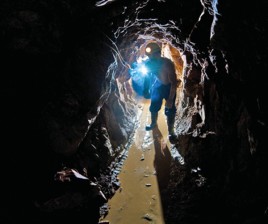
LIGHT IN THE TUNNEL Under EO 79, small-scale miners like the one above in Itogon, Benguet, will be confined to the “Minahan ng Bayan.” They are also banned from using mercury to process the mined ores. RICHARD BALONGLONG / INQUIRER NORTHERN LUZON
Of the country’s total land area of 30 million hectares, some 9 million ha have been identified as having “high mineral potential,” said the Mines and Geosciences Bureau (MGB).
As of January 2012, the bureau estimated that some 3.8 percent (around 1.14 million ha) of the Philippines’ total land area was covered by mining tenements.
As of June 2012, the country had 30 operating metallic mines—18 nickel mines, five gold mines with silver as coproduct, three copper mines with gold and silver as co-products, two chromite mines, a polymetallic mine with gold, silver, copper and zinc as products; and an iron mine, according to the MGB.
In 2011, the country’s total metallic mineral production was worth P122 billion, up from P112 billion in 2010. Gold production for 2011 alone was valued at P63.14 billion.
However, for the first quarter of 2012, data from the MGB showed that metallic mineral production declined from P31.4 billion in the same period last year to P19.6 billion this year.
Nickel mines are located in Zambales, Palawan, Agusan del Sur, Surigao del Norte and Surigao del Sur, while the gold with silver mines are in Benguet, Masbate, Camarines Norte, Davao del Norte and Agusan del Sur.
The copper with gold and silver mines are located in Benguet, Cebu and Zamboanga del Norte. The copper mine with gold, silver and zinc is in Albay, while the metallurgical chromite mines are in Surigao del Norte and Eastern Samar. The iron mine is in Leyte.
Mining contributed 1 percent (P99.2 billion) to the country’s gross domestic product in 2011, according to MGB data.
Investments in exploration and mining projects have amounted to more than $4.4 billion from 2004 to 2011.
The mining industry employs some 238,000 people, said the Department of Labor and Employment.
According to the Environmental Management Bureau, there were around 300,000 small-scale miners in the country as of December 2011. Compiled by Kate Pedroso, Inquirer Research
Sources: Mines and Geosciences Bureau website, Inquirer archives